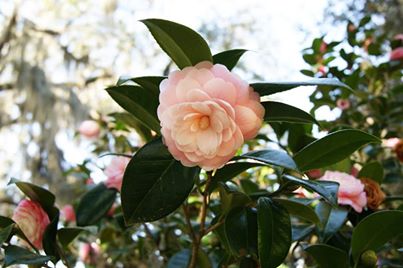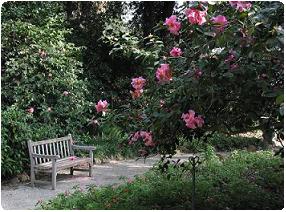 Camellias, often referred to as winter’s rose, light up the landscape from November to March. Originally from eastern and southern Asia, the evergreen foliage does best in light shade and a slightly acid, rich, well- drained soil. A soil pH (degree of acidity or alkalinity) of 6.0 – 6.5 is considered best for camellias. The “Camellia Belt” is generally regarded as USDA Hardiness Zone 7 – 9, although some cold-hardy hybrids have been developed.
Camellias, often referred to as winter’s rose, light up the landscape from November to March. Originally from eastern and southern Asia, the evergreen foliage does best in light shade and a slightly acid, rich, well- drained soil. A soil pH (degree of acidity or alkalinity) of 6.0 – 6.5 is considered best for camellias. The “Camellia Belt” is generally regarded as USDA Hardiness Zone 7 – 9, although some cold-hardy hybrids have been developed.
Gardens Famous for Camellias
- Middleton Place, Charleston, South Carolina. Centuries-old camellias (Camellia japonicas) bloom throughout the winter gardens in December through March. Located on the Ashley River Road outside of Charleston, S.C.
- Massee Lane Gardens, Fort Valley, GA. Home of the American Camellia Society and over 1000 camellias, Massee Lane Gardens is a 100+ acre botanical garden in Middle Georgia. The Gardens are the historic home of the American Camellia Society and have been designated as “A Garden of Excellence” by the Society. The cultivars include Camellia japonica, Camellia sasanquas, Camellia hybrids and other species. The Festival of Camellias is a month long celebration held in February, with the first Saturday as the kick-off.
- The Judge Arthur Solomon Camellia Trail is located at the Bamboo Farm & Coastal Gardens in Savannah, Georgia. A project of the Southeastern Camellia Society in cooperation with the University of Georgia and the Friends of Coastal Gardens, the Trail was begun in 2002. With sasanquas, snow, vernal and common camellias and their hybrids, it is one of the most diverse and unique collections of species camellias in North America. Located roughly 10 miles southwest of downtown Savannah.
- Descanso Gardens, La Cañada Flintridge, CA. North America’s largest camellia collection—more than 34,000 plants and more than 700 camellia taxa growing on 20 acres. The annual Camellia Festival is held Feb. 8 and 9, where forest sprites lead tours of the camellia collection for all ages. Tours last approximately 20 minutes and are on a first come, first served basis.
- Huntington Botanical Gardens, San Marino, CA. 12 acres of camellias, with sixty species and 1,200 cultivars, the Huntington has one of North America’s most comprehensive collections of camellias. The International Camellia Society has named the Huntington as an International Camellia Garden of Excellence, one of only five in the world.
From the Camellia Society, here are some common terms:
Japonica: one of the most well-known species of Camellias. Originally from mainland China, Taiwan, southern Korea, and southern Japan.
Reticulata: a species of Camellia native to southwestern China, with usually large, loose blooms.
Hybrid: a cross between multiple Camellia species.
Sasanqua: a species of Camellia native to southern Japan, usually shrubby, and with varying petal types.
Miniatures: blooms that are 2 1/2 inches or less in size.
Seedlings: blooms from a non-registered variety of Camellia that is unique from previously registered varieties.
Mutants: blooms from a plant of an established variety of Camellia, that differ from the standard look of that
variety’s blooms.
Unprotected: Camellias grown outside, not in a greenhouse.
Untreated: Camellias grown naturally, without the use of gibberellic acid.
Treated: A bloom that has been treated with gibberellic acid (called gibbing).
Gibbing: The technique of applying gibberellic acid to a bloom to induce growing and size.


